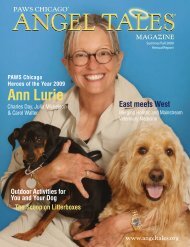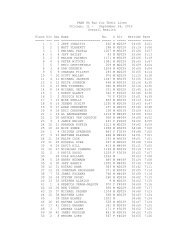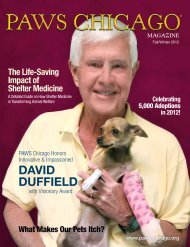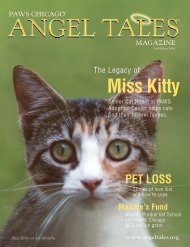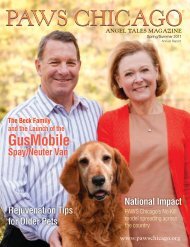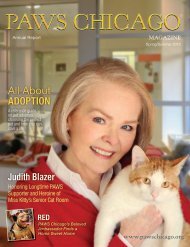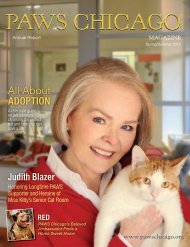paws-chicago-magazine-2011-winter
paws-chicago-magazine-2011-winter
paws-chicago-magazine-2011-winter
You also want an ePaper? Increase the reach of your titles
YUMPU automatically turns print PDFs into web optimized ePapers that Google loves.
Don’t be afraid toask for help. Inyour community, itis very likely thatthere are others goingthrough what youare going through.Anticipatory GriefWhen a terminal diagnosis is given, orif it is becoming evident that a pet doesnot have much time left, family membersmay begin to feel a great deal of sadness,anger, or a myriad of other emotions.These feelings, known as anticipatorygrief, are a form of grief that occurs priorto the loss. If these feelings become debilitating,the best course of action is toseek out a professional therapist, or tofind a local or online support group. Theemotions that accompany anticipatorygrief are often confusing and isolating.Talking through them in a professionalsetting may not alleviate these feelingsentirely, but they may ease some of thesecondary discomforts that often springfrom these emotions.With this in mind, it is essential thatfamilies take the appropriate actions inthe anticipatory stages to minimize thepotential for feelings such as self loathing,uncertainty, and guilt after the deathoccurs. Many times family members willsay, “What if we had done this,” or “Weshould have tried that.” A good way todefend against this is to have an end oflife plan in place before it is needed. Ifpossible, start by thinking about whatyou would do if you were given a terminaldiagnosis and start gathering facts inorder to be aware of all of your options.End of life care is continually changingand, if desired, euthanasia can be yourfamily’s last resort rather than the onlyoption. This may ultimately reduce thelevel of stress and guilt that is felt afterthe pet passes away.Pet HospicePet hospice and palliative care arequickly emerging as an end of life specialtyand, much like in human hospiceand palliative care, an emphasis is placedon managing pain and preservingdignity during the life to death transition.Dr. Amir Shanan of Chicago is theFounder of the International Associationof Animal Hospice and Palliative Care(IAAHPC.org) and owner of CompassionateVeterinary Care in LincolnPark. Dr. Shanan is leading the way forincreased awareness of end of life carethat is multi-faceted, and sensitive to theimportant differences in culture, faith,and emotional well-being of those whoare trying to navigate the often complicatedand evolving options for end of lifecare. IAAHPC members are progressivethinkers that are committed to both theanimals they serve as well as their survivinghumans.Pain management is a very importantcomponent of hospice and palliativecare. But it is important to keep in mindthat while physical pain management isa crucial part of palliative care, humanpain and grief management are viewed asequally important components. After all,end of life is an experience that createsthe foundation for healthy and effectivemourning in the days, months, and yearsthat follow the loss of family members.EuthanasiaMany times in the end of life stages, theanimal’s quality of life gets to the pointwhere euthanasia may be the most humaneand appropriate course of action.If, after consulting your veterinarian andfamily, you decide that euthanasia is theright choice, decide where you would likethe procedure to take place.Traditionally, euthanasia has been offeredmostly in a clinical setting; however,some veterinarians have begun offeringin-home euthanasia services due to ahuge increase in demand. This option,although sometimes a bit more expensive,can be a peaceful and fitting wayto say goodbye without having to worryabout removing an already struggling petfrom the comforts of home.If you opt for an in home serviceoffered by a veterinarian who is not yourpet’s regular veterinarian, be sure tonotify your regular veterinarian thatyour pet is no longer living. For one, theveterinarian and their staff often timesform an attachment to your pet asthey get to know them throughout theyears, and secondly, this will help yourveterinarian’s office avoid unintentionallyhurting or offending you by sendinghealth and well-being reminders.Continued on page 3837






